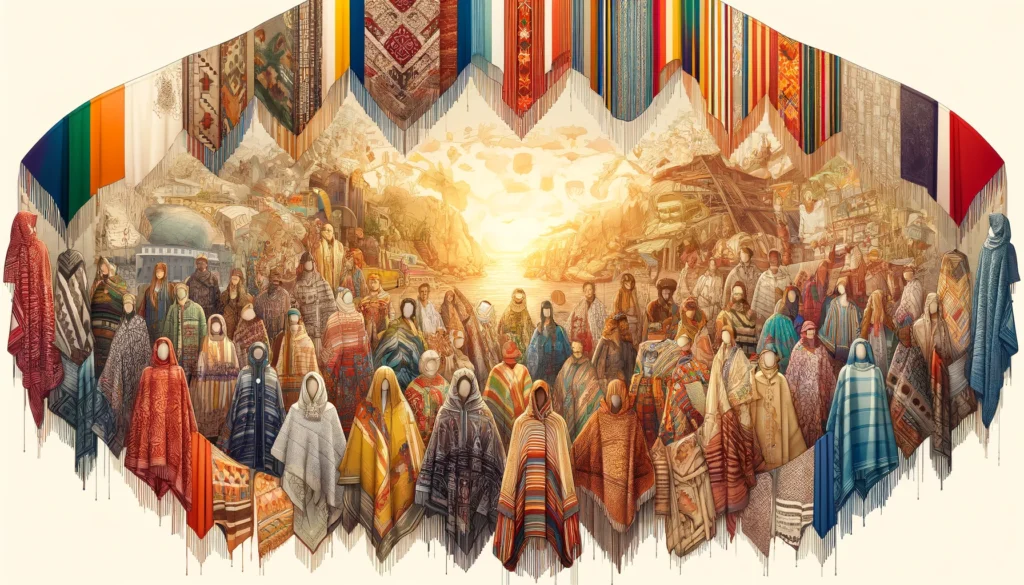The poncho, a simple yet profoundly versatile garment, has woven its way through the fabric of numerous cultures around the globe. From the wind-swept plains of South America to the rugged landscapes of Celtic regions, the poncho serves not just as a protective layer against the elements but also as a rich emblem of cultural identity. This exploration delves into the origins, variations, and cultural significance of ponchos, revealing the stories they carry and the traditions they uphold.
The Andean Ancestry
Roots in South America
The poncho’s journey begins in the heart of South America, where it was first crafted by the indigenous peoples of the Andes. Made from wool derived from llamas and alpacas, the traditional Andean poncho is characterized by its vibrant colors and intricate patterns, each symbolizing different aspects of the wearer’s identity and community.
Symbolism and Social Significance
In many South American cultures, ponchos play a crucial role in social and ceremonial events, embodying the wearer’s status, community ties, and even spiritual beliefs. The designs woven into each poncho tell stories of ancestral myths, the natural landscape, and the cosmos, offering a glimpse into the region’s rich cultural tapestry.
The Celtic Connection
Ponchos in Celtic Traditions
Moving across the Atlantic, the poncho finds resonance within Celtic traditions, particularly in regions like Ireland and Scotland. Here, the garment is known as a ‘brat’ or ‘plaid’ and is made from thick, water-resistant wool. While differing in style and material from their South American counterparts, Celtic ponchos share the common purpose of providing warmth and protection against harsh climates.

A Marker of Identity
In Celtic cultures, the poncho often served as a marker of identity, with different colors and patterns indicating clan affiliations. These garments played a significant role in historical and social rituals, from daily wear by warriors and hunters to ceremonial use in weddings and funerals, highlighting the poncho’s adaptability and enduring significance.
The Modern Metamorphosis
Ponchos in Contemporary Fashion
Today, the poncho transcends its traditional roots, embraced by the global fashion industry as a statement of style and sustainability. Contemporary designers draw inspiration from both South American and Celtic designs, merging them with modern aesthetics to create ponchos that appeal to a diverse, international audience.
Cultural Preservation and Innovation
As ponchos continue to evolve, they carry with them the stories and traditions of their origins. The modern poncho, whether worn on the streets of Paris or the mountains of Peru, serves as a testament to the garment’s ability to adapt while preserving its cultural heritage.
To identify the origin of a specific poncho design, examine the material, patterns, and colors used. South American ponchos often feature vibrant colors and intricate patterns reflecting indigenous cultures and landscapes. They’re typically made from llama or alpaca wool. In contrast, Celtic ponchos (brats or plaids) are usually made from thick, water-resistant wool and might display tartan patterns associated with different clans. The craftsmanship details and stylistic elements can also provide clues to its origins.
Yes, modern ponchos are still used in traditional ceremonies in various cultures, though the frequency and context might vary. In South America, ponchos continue to play a significant role in social and ceremonial events, embodying the wearer’s status and community ties. Similarly, in Celtic regions, although less common, ponchos or their equivalents may still appear in weddings, festivals, and other cultural gatherings, serving as a link to ancestral traditions.
Contemporary designers incorporate traditional elements into poncho designs by blending iconic patterns, colors, and materials with modern fashion trends. They may use traditional weaving techniques, indigenous patterns, or symbolic colors in a way that respects their cultural significance while adapting the garment’s silhouette, fabric, or functionality to suit modern tastes. This approach allows for a fusion of heritage and innovation, making the poncho a versatile and stylish garment that resonates with a global audience.
The poncho stands as a symbol of cultural resilience and adaptability, seamlessly blending tradition with modernity. As we wrap ourselves in its warmth, we also drape ourselves in the rich histories and vibrant cultures that have shaped this humble garment into a global icon.
